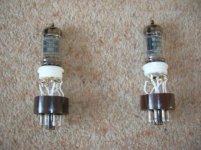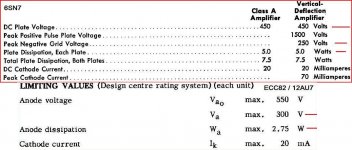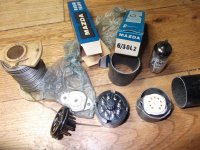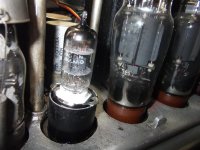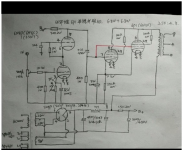Has anyone tried a "12au7 to 6sn7 adapter"?

I got a bunch of 12ax7 and 12au7 from my guitar amp.
How a 12au7 compares to 6SN7, with the same gain?
I read that the smaller 12au7 should hum less, half filament current, less microphonic, and less crosstalk between the two triodes.
A 12ax7 is probably too hot/gainy and will drive the grids of the power tube too early on the volume pot.
Anyway, it is nice to have an option to try a more common tube in the there.
Any experience?
I got a bunch of 12ax7 and 12au7 from my guitar amp.
How a 12au7 compares to 6SN7, with the same gain?
I read that the smaller 12au7 should hum less, half filament current, less microphonic, and less crosstalk between the two triodes.
A 12ax7 is probably too hot/gainy and will drive the grids of the power tube too early on the volume pot.
Anyway, it is nice to have an option to try a more common tube in the there.
Any experience?
Last edited:
Hi,
Absolutely no reason why it shouldn't work. According to various manufacturers the 12AU7 is the 9 pin noval equivalent of the 6SN7/7N7.
I recently built a pair of amplifiers with provision for fitting either 12AU7/6SN7/7N7. Tried all 3 types and found the the larger valves introduced more hum than the 12AU7. DC heating cured pretty well all of the hum. I "think" I preferred the larger valves but it was marginal.
John
Absolutely no reason why it shouldn't work. According to various manufacturers the 12AU7 is the 9 pin noval equivalent of the 6SN7/7N7.
I recently built a pair of amplifiers with provision for fitting either 12AU7/6SN7/7N7. Tried all 3 types and found the the larger valves introduced more hum than the 12AU7. DC heating cured pretty well all of the hum. I "think" I preferred the larger valves but it was marginal.
John
Something I found on other board:
John Caswell,
"think" + marginal and "a little better to me" is practically the same... maybe the 6SN7 has the looks factor which effects the sound?
Basically the 12AU7 is just a newer and better tube overall, minus the larger more impressive bottle... ?
I want to hear more opinions about how the two compare.
The primary difference between a 6SN7 and 12AU7 would be ten years of technological evolution (6SN7 evolving into the 12AU7). If you go backwards from the 6SN7, you'll find the single bottle 6J5, then the 76, 37, etc.
One way to judge the impact of physical size is to look at how much heat one of the plates can dissipate. A 12AU7 can burn off 2.75 Watts, while earlier 6SN7's are rated to 2.5 watts (the GTB/A can do more).
It's also worth noting that the overall geometry differences between the 6SN7 and 12AU7 lead the SN7 to have more stray capacitance, which may contribute to some of the observed sonic differences.
IMO, the very best of the 12AU7 family edge out the 6SN7, but an average 6SN7 will sound a little better to me than an average 12AU7.
John Caswell,
"think" + marginal and "a little better to me" is practically the same... maybe the 6SN7 has the looks factor which effects the sound?
Basically the 12AU7 is just a newer and better tube overall, minus the larger more impressive bottle... ?
I want to hear more opinions about how the two compare.
Last edited:
The primary difference between a 6SN7 and 12AU7 would be ten years of technological evolution (6SN7 evolving into the 12AU7).
Not really true, if by "technological evolution" the writer means "improved quality." The tubes are different, that is true. Besides capacitances and heaters, 6SN7 has significantly lower distortion than a 12AU7 in most circuits- whether that's desirable or not depends on whether you're building something for music production or music reproduction.
I recently purchased socket converters from a Chinese manufacturer to try ECC99 and 12BH7, instead of 6SN7. After that, I got another pair to try 6CG7 and Russian 6n6p. I am a very happy customer. Their converters look exactly like the photograph you posted. I think the build quality is very good, though I've never checked internal wiring.
Those Chinese converter saved my time, and actually look much better than my makeshift DIY converters with small tube sockets residing on top of the "nest".
Yoshi
Those Chinese converter saved my time, and actually look much better than my makeshift DIY converters with small tube sockets residing on top of the "nest".
Yoshi
Folks, you are forgetting that the 6C4 relates to the 12AU7 the same as the 6J5 relates to the 6SN7.
SY mentioned linearity. I'll firmly state that the 12AU7 is unsatisfactory as a voltage amplifier, because of its non-linearity. If you want to use Noval socket/Octal plug adapters, wire them up for the 6CG7/6FQ7/6GU7 group. The triodes in the 6CG7/6FQ7 are "identical" to those in the 6SN7. The 6GU7 contains the same triodes as the 12BH7, which are slightly lower in mu and somewhat lower in RP than those in the 6SN7, etc. Most of the time, a 6GU7 will drop into a 6FQ7 "hole", without incident.
BTW, 12BH7s are pin compatible with 12AU7s and will work in those commercially available adapters. The triodes in a 12BH7 are linear.
The triodes in a 12BH7 are linear.
SY mentioned linearity. I'll firmly state that the 12AU7 is unsatisfactory as a voltage amplifier, because of its non-linearity. If you want to use Noval socket/Octal plug adapters, wire them up for the 6CG7/6FQ7/6GU7 group. The triodes in the 6CG7/6FQ7 are "identical" to those in the 6SN7. The 6GU7 contains the same triodes as the 12BH7, which are slightly lower in mu and somewhat lower in RP than those in the 6SN7, etc. Most of the time, a 6GU7 will drop into a 6FQ7 "hole", without incident.
BTW, 12BH7s are pin compatible with 12AU7s and will work in those commercially available adapters.
I'll disagree with Eli and say that the 12AU7 can be quite nice, depending on where it is in your circuit and what sort of harmonic compliment it adds to the mix. Heath them in a Williamson configurationm in the W5 and that's a lovely-sounding amp. In terms of gain, take note that in low-current use it has the same gain as a 6SN7 but in higher-current situations it has less gain, and you will notice it. For example, in the Heath W5 design, if I substitute a 6SN7 for the input tube, there's no noticeable change in gain. But if I substitute a 6SN7 for the driver stage, there's an increase in gain. At any rate you have a choice.  In most situations a 12AU7 will drop in comfortably. I'm about to order a few of these adaptors so I can swap out tubes for a Williamson-style amp I'm building for a friend. He likes to have as many options as possible. ;-)
In most situations a 12AU7 will drop in comfortably. I'm about to order a few of these adaptors so I can swap out tubes for a Williamson-style amp I'm building for a friend. He likes to have as many options as possible. ;-)
"Something I found on other board".
He doesn't say what kind of "technological evolution" or to what end. While it's true that the static characteristics of the 12AU7 are very much like those of the 6SN7, the dynamic characteristics are quite different. The design goal was indeed less internal capacitance as the 12AU7 was intended for RF applications where you don't want that extra capacitance. This had a definite negative impact on sonic performance. Not unexpected as they were "evolving" a type that could perform at the higher SW/lower VHF frequencies.
If you look up circuits using 12AU7s, what you find are just ESSSSS-loads of RF circuits: mixer/oscillators, oscillator/buffers, PP frequency triplers, PP drivers, product detectors/SBMs. You also find lots of digital and quasi-digital applications: multivibrators, R-S latches/clocked flip-flops, squaring circuits (Schmidt Trigger) one shots. Audio applications: not so much. Used as gain stages (cathode followers are a different story) 12AU7s don't sound so good. Good audio loadlines are more difficult to find, and 12AU7s work best with active plate loads.
If you want a smaller bottle than the 6SN7, then you want a 6FQ7 or its near twin: the 6CG7 (the only difference is that the latter includes an internal baffle shield between triode sections). 12AU7s are likely to disappoint unless you like the effects of the resulting distortion or you're discussing guitar amps. If this were not the case, and the 12AU7 really is a better 6SN7, then why did they waste all that time making the 6FQ7 and 6CG7? These latter two types are "audio" tubes with sonic performance like the 6SN7 in the 9-pin mini format; the 12AU7 is an RF tube.
"The ECC83 or 12AX7 is almost the same as a 6SL7, save heater current".
Not at all. The characteristics are quite different. The u-factor of the 6SL7 is 70 (niminal) wheras that of the 12AX7 is 100. The other big difference is plate resistance: rp= 44K (6SL7) and rp= 90K (12AX7). That, tight there, makes a major difference. I've seen way too many designs where the plate loading was excessive in 12AX7 designs. An RP= 100K is a good load for a 6SL7, but barely adequate for a 12AX7. RP > 2rp for any triode.
Low distortion performance with triodes needs the lightest possible plate loading. Is it any wonder why the 12AX7 is thought to be a sonic under performer?
The primary difference between a 6SN7 and 12AU7 would be ten years of technological evolution (6SN7 evolving into the 12AU7). If you go backwards from the 6SN7, you'll find the single bottle 6J5, then the 76, 37, etc.
One way to judge the impact of physical size is to look at how much heat one of the plates can dissipate. A 12AU7 can burn off 2.75 Watts, while earlier 6SN7's are rated to 2.5 watts (the GTB/A can do more).
It's also worth noting that the overall geometry differences between the 6SN7 and 12AU7 lead the SN7 to have more stray capacitance, which may contribute to some of the observed sonic differences.
IMO, the very best of the 12AU7 family edge out the 6SN7, but an average 6SN7 will sound a little better to me than an average 12AU7.
He doesn't say what kind of "technological evolution" or to what end. While it's true that the static characteristics of the 12AU7 are very much like those of the 6SN7, the dynamic characteristics are quite different. The design goal was indeed less internal capacitance as the 12AU7 was intended for RF applications where you don't want that extra capacitance. This had a definite negative impact on sonic performance. Not unexpected as they were "evolving" a type that could perform at the higher SW/lower VHF frequencies.
John Caswell,
"think" + marginal and "a little better to me" is practically the same... maybe the 6SN7 has the looks factor which effects the sound?
Basically the 12AU7 is just a newer and better tube overall, minus the larger more impressive bottle... ?
I want to hear more opinions about how the two compare.
If you look up circuits using 12AU7s, what you find are just ESSSSS-loads of RF circuits: mixer/oscillators, oscillator/buffers, PP frequency triplers, PP drivers, product detectors/SBMs. You also find lots of digital and quasi-digital applications: multivibrators, R-S latches/clocked flip-flops, squaring circuits (Schmidt Trigger) one shots. Audio applications: not so much. Used as gain stages (cathode followers are a different story) 12AU7s don't sound so good. Good audio loadlines are more difficult to find, and 12AU7s work best with active plate loads.
If you want a smaller bottle than the 6SN7, then you want a 6FQ7 or its near twin: the 6CG7 (the only difference is that the latter includes an internal baffle shield between triode sections). 12AU7s are likely to disappoint unless you like the effects of the resulting distortion or you're discussing guitar amps. If this were not the case, and the 12AU7 really is a better 6SN7, then why did they waste all that time making the 6FQ7 and 6CG7? These latter two types are "audio" tubes with sonic performance like the 6SN7 in the 9-pin mini format; the 12AU7 is an RF tube.
"The ECC83 or 12AX7 is almost the same as a 6SL7, save heater current".
Not at all. The characteristics are quite different. The u-factor of the 6SL7 is 70 (niminal) wheras that of the 12AX7 is 100. The other big difference is plate resistance: rp= 44K (6SL7) and rp= 90K (12AX7). That, tight there, makes a major difference. I've seen way too many designs where the plate loading was excessive in 12AX7 designs. An RP= 100K is a good load for a 6SL7, but barely adequate for a 12AX7. RP > 2rp for any triode.
Low distortion performance with triodes needs the lightest possible plate loading. Is it any wonder why the 12AX7 is thought to be a sonic under performer?
I woluld qualify this. The 6SN7 is only a strikingly low-distortion valve when operating into a high-impedance load, e.g. CCS. Into a more traditional resistor load, the 12AU7 and 6SN7 both produce very similar levels of distortion (hovering around 1% at 10Vrms output). The carbonised 6SN7 is usually a little better (perhaps 0.7%), but the differences are not nearly as great as some posters want to imply. If you're using traditional resistor loading, the 12AU7 is nothing to be ashamed of.Used as gain stages (cathode followers are a different story) 12AU7s don't sound so good. Good audio loadlines are more difficult to find, and 12AU7s work best with active plate loads.
Need your help
Hi I saw a post u replied in regards to its not always safe to use the 12AU7 instead of 6SN7. If U have knowledge of this, can u tell me if it would be safe in my headphone amp..?
It’s a Chinese Nobsound 6P1 amp. 6.8W/channel...
Uses 2x 6P1 in parallel.
I have attached schematic.
Thx.
It's not always safe to replace a 6SN7 by a ECC82
For preamp's normaly no problem, but when driving output tubes and other more demanding circuits better check first.
Mona
Hi I saw a post u replied in regards to its not always safe to use the 12AU7 instead of 6SN7. If U have knowledge of this, can u tell me if it would be safe in my headphone amp..?
It’s a Chinese Nobsound 6P1 amp. 6.8W/channel...
Uses 2x 6P1 in parallel.
I have attached schematic.
Thx.
Attachments
To All,
1. Again, wrap lots of Global Negative Feedback around an amplifier, and it may sound similar with several tube types in one of the stages.
The question is, what do those various tube types sound like, when there is no negative feedback applied?
Back in 1997, at VSAC in Silverdale, Washington, a listening session had very many triode types compared in a line stage preamplifier (bare bones, no negative feedback).
Rightly or wrongly, everybody was surprised, the 12AU7 won as the best in the listening session.
Do Not take this as a scientific listening session, and the same goes for the "results".
Just a single point of interest.
As always, Your Mileage May Vary.
VSAC = Vacuum tube State of the Art Conference.
2. To:
maddmaxxdrummer,
(and to all who want to use that schematic)
The headphone amplifier in post # 17 does not have any negative feedback.
Note: There needs to be a self bias resistor in the top triode of the cascode amplifier (between the cathode, and junction of the bottom of the 1Meg grid resistor and plate of the bottom triode in the cascode amplifier, right?
Otherwise you will get clipping (the top triode is at Zero bias, not correct for that tube to operate in a linear fashion).
1. Again, wrap lots of Global Negative Feedback around an amplifier, and it may sound similar with several tube types in one of the stages.
The question is, what do those various tube types sound like, when there is no negative feedback applied?
Back in 1997, at VSAC in Silverdale, Washington, a listening session had very many triode types compared in a line stage preamplifier (bare bones, no negative feedback).
Rightly or wrongly, everybody was surprised, the 12AU7 won as the best in the listening session.
Do Not take this as a scientific listening session, and the same goes for the "results".
Just a single point of interest.
As always, Your Mileage May Vary.
VSAC = Vacuum tube State of the Art Conference.
2. To:
maddmaxxdrummer,
(and to all who want to use that schematic)
The headphone amplifier in post # 17 does not have any negative feedback.
Note: There needs to be a self bias resistor in the top triode of the cascode amplifier (between the cathode, and junction of the bottom of the 1Meg grid resistor and plate of the bottom triode in the cascode amplifier, right?
Otherwise you will get clipping (the top triode is at Zero bias, not correct for that tube to operate in a linear fashion).
Last edited:
12AU7 to 6SN7
Hi, so is it safe to try 12AU7 electrically? based on this schematic ?
One of the posters had mentioned that when driving output tubes it may not be safe.
Im assuming these preamp tubes are driving the 6P1 power tubes
So I’m wanting to make sure before I try it.
Because i have some Telefunken 12AU7s and would just need to get the socket adaptors.
Thx.
Hi, so is it safe to try 12AU7 electrically? based on this schematic ?
One of the posters had mentioned that when driving output tubes it may not be safe.
Im assuming these preamp tubes are driving the 6P1 power tubes
So I’m wanting to make sure before I try it.
Because i have some Telefunken 12AU7s and would just need to get the socket adaptors.
Thx.
With a 2.2k bottom triode self bias resistor, and dividing the B+ voltage between the bottom and the top triode sections, and with the 30k plate resistor, you are not going to over-dissipate a 12AU7 in the input stage.
You might try using another 2.2k self bias resistor in the top triode of the cascode.
That will make the voltages across the 2 triodes the same.
But be sure to use a bypass cap across the added self bias resistor to retain the cascode topology.
You may need to reduce both of the 2.2k self bias resistors, the original one, and the added one.
The B+ is divided between the bottom triode, the top triode, and the 30k plate resistor.
I suggest using the JJ 12AU7 from Eurotubes.com.
The filament is spiral wound, not the common filament of today.
The original Amperex spec for the 12AU7 was spiral wound, not just serial up and down multiple filament wires.
The spiral filament may give less hum and noise.
Eurotubes.com retests the JJ tubes for hum and noise.
Telefunken should work good too (but do take a look to see if the filament wires are spiral wound).
You might try using another 2.2k self bias resistor in the top triode of the cascode.
That will make the voltages across the 2 triodes the same.
But be sure to use a bypass cap across the added self bias resistor to retain the cascode topology.
You may need to reduce both of the 2.2k self bias resistors, the original one, and the added one.
The B+ is divided between the bottom triode, the top triode, and the 30k plate resistor.
I suggest using the JJ 12AU7 from Eurotubes.com.
The filament is spiral wound, not the common filament of today.
The original Amperex spec for the 12AU7 was spiral wound, not just serial up and down multiple filament wires.
The spiral filament may give less hum and noise.
Eurotubes.com retests the JJ tubes for hum and noise.
Telefunken should work good too (but do take a look to see if the filament wires are spiral wound).
Last edited:
- Home
- Amplifiers
- Tubes / Valves
- Has anyone tried a "12AU7 to 6SN7 Adapter"?
